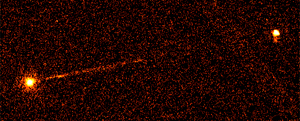June 6, 2000
CXC PR: 00-15
NASA's Chandra X-ray Observatory has revealed a spectacular luminous spike of X rays that emanates from the vicinity of a giant black hole in the center of the radio galaxy Pictor A. The spike, or jet, is due to a beam of particles that streaks across hundreds of thousands of light years of intergalactic space toward a brilliant X-ray hot spot that marks its end point.
The hot spot is at least 800 thousand light years (8 times the diameter of our Milky Way galaxy) away from where the jet originates. It is thought to represent the advancing head of the jet, which brightens conspicuously where it plows into the tenuous gas of intergalactic space. The jet, powered by the giant black hole, originates from a region of space no bigger than the solar system.
"Both the brightness and the spectrum of the X rays are very different from what theory predicts," Professor Andrew Wilson reported today at the 196th national meeting of the American Astronomical Society in Rochester, New York. Wilson, of the University of Maryland, College Park, along with Dr. Patrick Shopbell and Dr. Andrew Young, also of the University of Maryland, are submitting an article on this research to the Astrophysical Journal. "The Chandra observations are telling us that something out there is producing many more high-energy particles than we expected," said Wilson.
One possible explanation for the X rays is that shock waves along the side and head of the X-ray jet are accelerating electrons and possibly protons to speeds close to that of light. In the process the electrons are boosted to energies as high as 100 million times their own rest mass energy. These electrons lose their energy rapidly as they produce X rays, so this could be the first direct evidence of this process so far outside a galaxy.
The hot spot has been seen with optical and radio telescopes. Radio telescopes have also observed a faint jet. Jets are thought to be produced by the extreme electromagnetic forces created by magnetized gas swirling toward a black hole. Although most of the material falls into the black hole, some can be ejected at extremely high speeds. Magnetic fields spun out by these forces can extend over vast distances and may help explain the narrowness of the jet.
The Chandra observation of Pictor A was made on January 18, 2000 for eight hours using the Advanced CCD Imaging Spectrometer (ACIS).
The ACIS instrument was built for NASA by the Massachusetts Institute of Technology, Cambridge, and Pennsylvania State University, University Park. NASA's Marshall Space Flight Center in Huntsville, Ala., manages the Chandra program. TRW, Inc., Redondo Beach, Calif., is the prime contractor for the spacecraft. The Smithsonian's Chandra X-ray Center controls science and flight operations from Cambridge, Mass.
Images associated with this release are available on the World Wide Web at:
High resolution digital versions of the X-ray image (JPG, 300 dpi TIFF) are available at the Internet sites listed above. This image will be available on NASA Video File which airs at noon, 3:00 p.m., 6:00 p.m., 9:00 p.m. and midnight Eastern Time. NASA Television is available on GE-2, transponder 9C at 85 degrees West longitude, with vertical polarization. Frequency is on 3880.0 megahertz, with audio on 6.8 megahertz.
MEDIA CONTACTS
Dolores Beasley
Headquarters, Washington, DC
Phone: 202/358-1753
Steve Roy
Marshall Space Flight Center, Huntsville, AL
Phone: 256-544-6535
Leon J. Tune
University of Maryland, College Park, MD
Phone: 301-405-4679
Dr. Wallace Tucker
Chandra X-ray Observatory Center, CfA, Cambridge, MA
Phone: 617-496-7998



